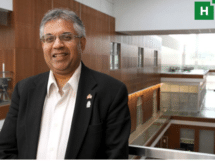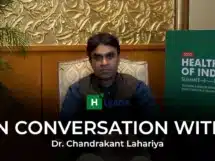In an exclusive interview with HealthLEADS, Dr (Colonel) Avnish Seth, Head – Department of Gastroenterology & Hepatology and Manipal Organ Sharing & Transplant (MOST), Manipal Hospital, New Delhi, sheds light on the shortage of organs, impact of misinformation, and perils of xenotransplantation.

“Asia accounts for over two-thirds of the world population, but less than 10% of global organ donations happen here. Social and cultural diversity plays an important part,” notes Dr (Colonel) Avnish Seth, Head – Department of Gastroenterology & Hepatology and Manipal Organ Sharing & Transplant (MOST), Manipal Hospital, New Delhi, India.
In India, organ donation is regulated by the Transplantation of Human Organs and Tissues Act, 1994. According to the National Organ Transplant Programme (NOTTO), there is a wide gap between patients who need transplants and the organ donors.
“Even though India carries out the third-highest number of organ transplants in the world after US and China, more than 70% of these are carried out in private hospitals,” informs Dr Seth, who is also a member of the Apex Technical Committee, NOTTO and an Advisory Board Member of Multi Organ Harvesting Aid Network (MOHAN) Foundation.
A pioneer in the field of organ donation, Dr Seth has played a pivotal role in establishing the Armed Forces Organ Retrieval & Transplant Authority (AORTA) and was Head of Transplant Hepatology with the team that conducted the first successful liver transplant programme in a government hospital in India.
In a wide-ranging interview, Dr Seth talks about the current state of affairs, the challenges, opportunities, and more.
Edited excerpts from the interview:
How is the organ donation scenario in Asia?
In South Korea, the organ donation rate is low. Organ donation is considered against nature and the citizens’ desire to be buried in peace after death as a whole. Singapore too has an organ donation rate of only 6.5 per million population, despite an opt-in system since 1987.
In Japan, cultural issues including concerns about the mutilation of the body due to organ donation limit the organ donation rate below one per million. It’s important to note that no religion is against organ donation. Iran has shown the way with an organ donation rate of over 10 per million population.
How grave is the shortage of organ donors in India?
While the law for organ donation and transplantation was enacted way back in 1994, even today there remains a huge gap in the demand and supply of organs. An estimated 1.8 lakh individuals suffer from kidney failure every year, but only 10,000 kidney transplants are done annually. Against an estimated requirement of 25,000 liver transplants, only 2000 are being carried out every year.
Similarly, about 50,000 persons suffer from heart failure, but less than 200 heart transplants are performed. The requirement for lung, intestine and pancreas transplantation, likely to be considerable, remains unknown. The most common tissue transplant is that of the cornea. We carry out close to 25,000 corneal transplants every year in India against an estimated requirement of 1,00,000.
What are the criteria for retrieving organs for a transplantation?
Organ donation is usually done in India following brain death. Brain death is seen in patients with severe head injury or stroke. The brain dies, but as the breathing is supported artificially on ventilator, the heart continues to beat for a few hours to a few days. Thus, keeping the vital organs alive.
It’s important to note that brain death is irreversible. Brain death is death. This window between brain death and cardiac standstill is the period when organs may be retrieved for transplantation. The decision to use the organs or not is based on strict medical criteria that are assessed by experts prior to each organ retrieval.
What are the key impediments to organ donation?
The impediments are at three levels. First, at the level of the government. Health is a state subject in India. So, even if the Central Government passes a law related to health, the states need to adopt the same. The amended Transplantation of Human Organs and Tissues Act was enacted by the Government of India in 2011. However, several states and union territories are yet to adopt the law. Also, India spends less than 2% of its Gross Domestic Product (GDP) on health. Trauma services need revamping. While a few public hospitals do outstanding work, the majority face a shortage in critical care specialists and infrastructure.
Second, low public awareness, socio-cultural and religious factors have been cited as the main reason for the low organ donation rate. Third, critical care teams could better in early recognition and declaration of brain death in ICUs across the country. The ‘required request’ spelt out in Transplantation of Human Organs and Tissues Rules 2014, which mandates counselling of families of patients with brain death for organ donation, is often ignored.
Do poor logistic facilities hamper optimal utilisation of donated organs?
Organs like kidneys and liver are utilised completely. On the other hand, the heart and lungs are often under-utilised due to limited transplanting hospitals, short waiting lists, and issues with matching and transportation within limited time frames.
The heart has to be transplanted within four hours of retrieval, while kidneys are the most forgiving and can be transplanted even 24 hours after retrieval. Transplantation of the small intestine and pancreas is carried out in very few centres.
Why are organ transplants still inaccessible to most people?
Over 70% of organ transplants are carried out at private hospitals in India, and often at enormous costs. The government has now initiated steps to ensure that there is at least one public hospital in each state equipped to conduct transplant surgeries. Also, provision is being made for easy access to the expensive immunosuppressive medication, required life-long after transplantation, at a subsidised cost.
Health insurance is also in its infancy in India. While all these steps are being implemented, there is no doubt that as of now, the majority of organ transplants are available to only those who can afford them.
What has caused the organ trafficking problem in Southeast Asia?
Southeast Asian countries have limited resources and poor organ donation rates. This, in part, reflects the poor health infrastructure in these countries. Organ donation is a part of excellence in healthcare and end-of-life care. It must not be viewed in isolation.
In the absence of structured healthcare, families of patients dying with end-stage organ failure resort to desperate measures to save their loved ones. Poverty lends itself to exploitation. The only way to reduce organ trafficking is to improve deceased organ donation after brain death and also circulatory death. World Health Organization (WHO) has called upon all countries to pursue self-sufficiency in organ transplantation, both by decreasing disease burden and increasing the availability of organs.
What is the scope for xenotransplantation?
Given the paucity of organs from deceased donors, humans ventured to look at organs from non-human primates like monkeys. However, due to the risk of cross-species transmission of infections and ethical concerns, this was soon given up. The pig model has been the focus of research for the last two decades because of physiological similarities to humans, large litter size of 10 or more, short gestation period of less than four months and less risk of transmission of infections.
However, immunological barriers remain a challenge with xenotransplantation. This problem is being addressed by the scientific community with the application of genetic engineering to produce porcine organs that are resistant to rejection and also by using more advanced medications for immunosuppression.
At the same time, it is important to have regulations in place. In India, for example, a pig heart was transplanted into a human body in Assam in 1997. The patient died in a week and that lead to the arrest of the concerned doctors. Several countries have passed an ordinance on xenotransplantation and it is time that we did so in Asia.
What are the most common myths about organ donation?
The three common myths about organ donation are:
* My religion does not permit organ donation.
Every religion teaches the core values of love, kindness, sharing and caring. There is no religion, culture or custom that refutes the act of giving.
* Organ or tissue retrieval will hurt the donor.
The dead donor rule is always followed in organ and tissue donation. Brain death is death and the deceased cannot perceive pain even though the heart is still beating.
* The body will be disfigured because of organ retrieval.
The body of the donor is handled with utmost respect and dignity. Trained clinicians retrieve the organs with precision and stitch the body in a neat and clean manner in the operation theatre.
We need to spread greater awareness about organ donation. Activities to promote organ donation shouldn’t be limited to Organ Donation Week or Organ Donation Day. There is a need for year-round awareness campaigns, supported by the government and private entities. These efforts will go a long way in reaching the ‘tipping point’ on awareness vis-à-vis organ donation.

















